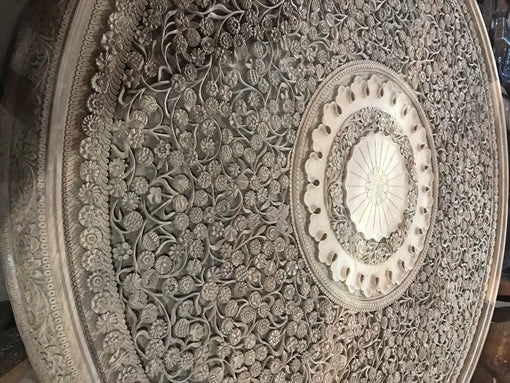
- Article published at:
- Article author: Hamiast Global
- Article comments count: 1
Drawer menu
In the misty valleys of Kashmir, where ancient traditions intertwine with breathtaking landscapes, a quiet yet profound artistry has thrived for centuries. It is not just craft—it is a legacy, meticulously stitched into fabric by generations of artisans. Kashmiri Chain Stitch and Crewel Embroidery are more than mere techniques; they are an enduring testament to human patience, skill, and devotion to beauty.
Step into this world, where every thread tells a story, every motif whispers of history, and the rhythm of the needle echoes the passage of time.
The origins of Kashmiri embroidery are as layered as the patterns that adorn its fabrics. The 14th century saw the arrival of Mir Sayyid Ali Hamadani, a Persian scholar and Sufi saint, whose influence extended beyond spiritual teachings to craftsmanship. He and his followers introduced an array of handicrafts to Kashmir, among them the intricate embroidery traditions that would evolve into the famous Chain Stitch and Crewel work we know today.
These techniques, refined over generations, absorbed the aesthetic influences of the Mughal courts, the grandeur of Persian artistry, and the natural splendor of the Kashmiri landscape. With every stitch, artisans transformed plain fabrics into works of art, capturing the beauty of chinar leaves, swirling vines, and exquisite paisley motifs.
Kashmiri embroidery is often tied to the region’s deep-rooted storytelling traditions. The motifs themselves narrate tales of the valley’s breathtaking seasons—spring’s almond blossoms, summer’s lush meadows, autumn’s golden chinar leaves, and winter’s snow-capped peaks. Passed down through families, each piece of embroidery carries with it not just an aesthetic legacy but an emotional one, linking artisans to their ancestors and preserving a cultural identity that has withstood the test of time.
Words, much like embroidery, carry their own lineage.
The name Chain Stitch derives from the distinctive interconnected loops created using a hooked needle known as an Aari. The technique allows for sweeping, fluid designs that flow effortlessly across the fabric, much like ink on a manuscript.
The word Crewel can be traced back to the late 15th century, referring to a special type of thin, worsted wool yarn used in embroidery. Unlike common misconceptions, the term is not linked to the word cruel but rather remains of uncertain linguistic origin, embedded deep in the history of textile craftsmanship.
Embroidering a piece of Kashmiri Chain Stitch or Crewel work is no hurried affair. It is a process measured not in minutes but in days, sometimes even months. Each artisan, with calloused yet graceful fingers, follows a rhythm—an unspoken language between hand, fabric, and thread.
Fabric Selection: The foundation is set with fine cotton, silk, or velvet.
Design Transfer: The motif, often inspired by nature or Persian miniature art, is first traced onto the fabric.
Aari Embroidery: With a hooked needle, artisans create continuous, looping stitches, forming delicate motifs with an almost painted effect.
Final Touches: The finished fabric is stretched, washed, and prepared for its final form—whether a wall hanging, a cushion cover, or an heirloom rug.
Base Material: Linen, cotton, or jute serves as the canvas.
Pattern Creation: Larger, more pronounced floral and vine patterns are sketched onto the fabric.
Needlework: Unlike Chain Stitch, Crewel involves long and short stitches, creating a raised, textured effect with woolen threads.
Finishing Touches: The completed embroidery is steamed and set, often destined for upholstery, bedspreads, or decorative panels.

Each piece is painstakingly worked upon, often involving multiple artisans contributing to different stages of the embroidery. It is not uncommon for a single piece to take weeks, if not months, to complete, depending on the complexity of the design and the size of the fabric.
Over time, these embroidery styles have given rise to multiple variations, each reflecting a distinct artistic sensibility.
Single-Color Chain Stitch: Understated elegance in monochrome.
Multi-Color Chain Stitch: A vibrant tapestry of hues and textures.
Floral Chain Stitch: Inspired by the lush landscapes of Kashmir.
Persian Motif Chain Stitch: A nod to the grandeur of Mughal and Persian influences.
Traditional Crewel Work: Earthy tones with classic Kashmiri motifs.
Raised Crewel Embroidery: Embossed designs that add depth and texture.
Modern Crewel Work: A fusion of silk and metallic threads for a contemporary appeal.
Geometric Crewel Patterns: Where tradition meets modern minimalism.
Beyond textiles, the influence of Kashmiri embroidery can now be seen in unexpected places—from haute couture runways to boutique home décor collections, making it an art form that continues to evolve.
As the world evolves, so too does Kashmiri embroidery. What was once reserved for palatial furnishings has found its place in modern wardrobes, luxury interiors, and global fashion.
Fashion Renaissance: Designers are weaving Kashmiri embroidery into contemporary clothing, blending tradition with modernity.
Home Décor Revival: Embroidered cushion covers, wall hangings, and statement rugs are now centerpieces in eclectic, bohemian, and luxury homes.
Sustainability & Ethical Craftsmanship: As the demand for slow fashion and ethical production rises, handcrafted embroidery has regained its well-deserved prominence.
E-commerce & Global Demand: Digital platforms have given Kashmiri artisans a direct link to global buyers, ensuring their art continues to thrive.
There is something inherently poetic about Kashmiri embroidery. It is a craft that defies time, one where history, patience, and artistic expression intertwine seamlessly. Each piece is not merely fabric adorned with thread—it is a story, a heritage, a testament to human creativity.
From the bustling bazaars of Srinagar to the ateliers of global fashion houses, these exquisite embroideries continue to enchant the world, just as they have for centuries.
If you long to own a piece of this timeless artistry, explore our collection at Hamiast.com—where heritage meets modern elegance, and every stitch holds a story worth cherishing.